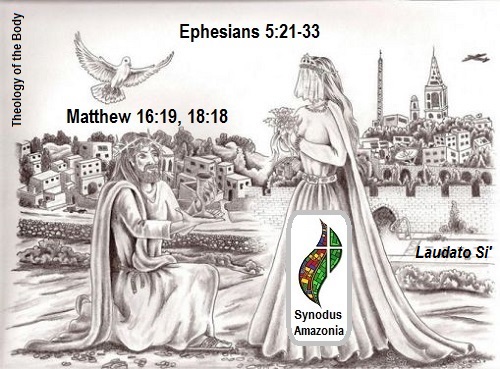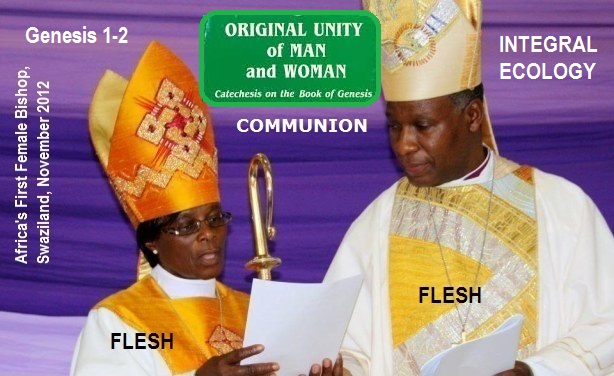"Submit to one another out of reverence for Christ... This is a profound mystery—but I am talking about Christ and the church..." Ephesians 5:21-33
The nuptial dimension of human ecology is encapsulated in Ephesians 5:21-33, the well known analogical allegory of the nuptial covenant between Christ and the Church. Even though it is written in the context of a patriarchal society, it describes a reality of living communion -- love of each other, care of each other, sacrifice for each other -- that transcends all cultural conditionings and role stereotypes: "submit to one another."
Cultural evolution, and biophysical realities, are bringing us now to the point of recognizing that there is a nuptial covenant between humanity and the ecosphere. As we are affected by the symptoms of the ecological crisis -- deforestation, industrial toxicity, air pollution, water pollution, contaminated food chains, biodiversity losses, and many other forms of ecological degradation -- it is time to recognize that abusing the planet that is our common home deviates from "submit to one another" and constitutes "domestic violence" of a kind and magnitude that corrupts the nuptial covenant between humanity and the ecosphere.
Just as there is a nuptial covenant between God and humanity that is made visible by the nuptial covenant between spouses when they become "one flesh", there is a cosmic covenant between God and the entire community of creation. This covenant is also nuptial, and is made visible by the existential coupling of humanity and the biosphere; for "all flesh is grass" and, therefore, humanity and the biosphere are "one flesh."
If "all grass" is destroyed, "all flesh" perishes. What is precipitating this nuptial tragedy?
"It’s our population growth that underlies just about every single one of the problems that we’ve inflicted on the planet. If there were just a few of us, then the nasty things we do wouldn’t really matter and Mother Nature would take care of it — but there are so many of us." Jane Goodall, interview with Agence France-Presse, 2010
A finite amount of grass can sustain only a finite number of humans, and now climate change (possibly anthropogenic) can reduce the carrying capacity of the planet even as population keeps growing. Even if consumption per capita is reduced to subsistence level, the planet has a finite capacity to sustain living human bodies, and it is not reasonable to expect any miraculous technologies that convert humans to bodiless free spirits.
Thus it is evident that responsible parenthood, including responsible regulation of natality, is a must if humanity is to survive the ecological crisis. Such responsible parenthood entails balancing family size and the common good of the family and other people, and this is the nuptial dimension of human ecology.
Is it conceivable to attain a culture of nuptial communion and responsible parenthood in a patriarchal society? No, because patriarchy reduces body-persons to sexual objects and, therefore, nuptial communion is replaced by aberrations such as sexual promiscuity, single parents (mostly women, most men conveniently evading responsibility), and all manner of sexual abuse including the horrors of rape and human trafficking.
As long as the original communion of man and woman remains corrupted by the patriarchal mindset, it is impossible to restore the original communion between humanity and the entire community of creation.
When the human body is just a sexual object to be used and abused, can we expect people to care for the planet and all the natural resources that sustain life? No, of course not; and all patriarchal institutions -- both secular and religious -- share responsibility in shaping a culture that degrades the nuptial meaning of the body and therefore degrades both the nuptial covenant between spouses and the nuptial covenant between humanity and the human habitat.
In the Catholic and Orthodox churches, for example, women cannot be ordained to the priesthood and the episcopate. Why not? Why is it that male headship precludes female headship? Why is it that Christ is Groom and the Church is Bride? Why not also the other way around? Are there two ontologically different and mutually exclusive human natures, one male and one female? Not according to the Theology of the Body (TOB), where the exegesis of Genesis 1-2 (see, e.g., this chapter) makes clear that sexual differentiation does not cancel the unity and consubstantiality of man and woman in one and the same homogeneous flesh, one and the same human nature; and the exegesis of Ephesians 5:21-22 makes clear that Pauline texts are "rooted in the mentality of his time" (TOB, p. 478) and by no means reduce the Christ-Church mystery to a patriarchal covenant.
For 20 centuries after the redemption, the exclusively male priesthood has remained a tragedy under the New Law. Now it is both a tragedy and a travesty. The Church does have the authority to ordain women, because Christ is Lord and Savior but not a patriarch, and has already submitted to the will of the Church (Matthew 16:19, 18:18). Since the Church has the authority to forgive sins, it is preposterous to keep insisting that she is not authorized to ordain women to the diaconate, the priesthood, and the episcopate. How much longer are we going to keep perpetuating the tragedy of religious patriarchy that has done so much damage to the human family and the entire human ecology?
In the Catholic Church, it is time to ordain married women to the diaconate, and it is time to ordain celibate women to the priesthood and the episcopate. In the nuptial dimension of human ecology, religious institutions have a very especial responsibility to clarify the conflation of patriarchal gender ideology (which emerged as a consequence of "original sin" -- Genesis 3:16) and the mysteries of the Christian faith. Else, when it comes to current issues of social/ecological justice, patriarchal religions are part of the problem, not part of the solution. Hopefully, the forthcoming synod of bishops on "Amazonia: New Paths for the Church and for an Integral Ecology" (October 2019) will examine this reality in light of the Theology of the Body and the encyclical Laudato Si'.
As long as the human ecology is corrupted by patriarchy, there can be no integral human development and there can be no integral ecology.

Christ has already submitted to the will of the Church: Matthew 16:19, 18:18
Religious Patriarchy in the Judeo-Christian Tradition

Female and Male Bishops ~ Anglican Church of Southern Africa
Summary Points for Meditation on the Ordination of Women